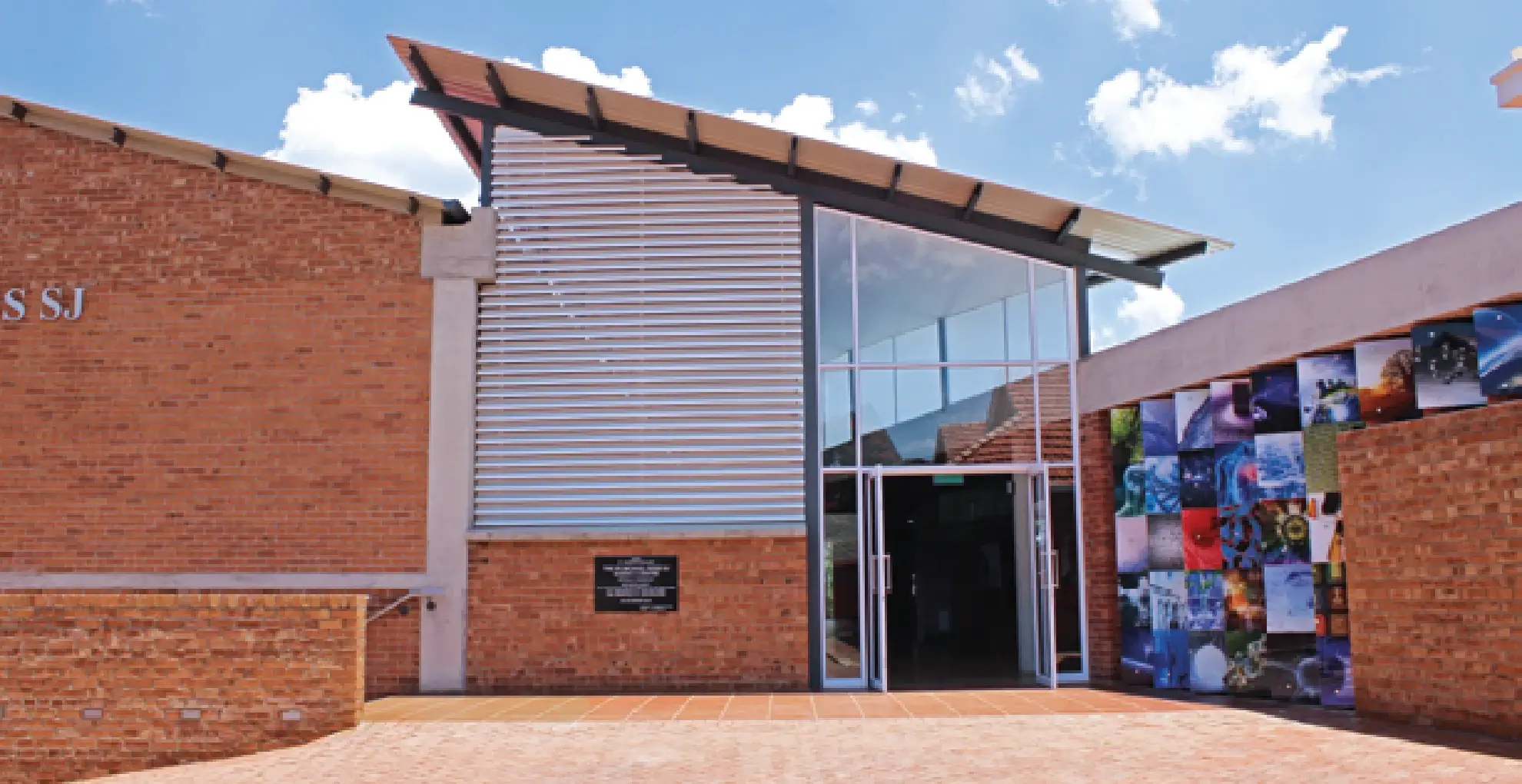From modest beginnings St George’s College has grown into one of the best schools on the continent. In 2003 Africa Almanac ranked St George’s 5th out of the 100 best schools in all of Africa. Bulawayo Boys’ Public School was founded in Bulawayo in 1896 by a French Jesuit, Fr Marc Bathélemy SJ. (The SJ after his name stands for the Society of Jesus or the Jesuit order and the school remains a Catholic school to this day.) Initially the school building was a small corrugated-iron hut with two windows and there were just six pupils. It was called Bulawayo Boys’ School at the time. Two years later in 1898 there were 25 pupils and a permanent building was erected.
In December of that year, at the first prize-giving ceremony, the school was renamed St George’s Boys’ Public School. As more teachers arrived from overseas and more pupils were enrolled the original site was considered too restricted and too close to the town centre of Bulawayo. The Jesuits already owned property in what was then Salisbury – Hartmann Hill – which at that time was a pleasant, rural site considered ideal for educating young men – so in 1927 the school relocated to Salisbury. The original cottage on the site was replaced by the impressive castle[1]like Administration block – reminiscent of Hogwarts from the Harry Potter films!
The architect for the early buildings was Fr Louis Lebœuf SJ and the main builder was Br John Conway SJ. In 1934 Sir Robert Stanley established the Beit Hall. In 1940 the Fr Crehan Library was built, in 1955 the new dormitory wing and the laboratories were built and in 1973 the permanent Chapel was constructed. These are just some of the highlights of the history of the development of the College as it has grown from just a few pupils to the current enrolment of over 700 students.
In the years before Independence government schools in what was then Rhodesia were racially segregated. St George’s, being a private school, was allowed a limited number of black students, which was considered very liberal at the time. The College’s first multi-racial intake was in 1963 and St George’s has continued to foster forward looking policies. As the school has continued to grow there has been more and more pressure on the available classroom space. In particular the classrooms or laboratories for the science subjects, which were ordinary classrooms that had been adapted many years ago, were no longer adequate or fit for purpose.
As part of a larger and on-going development scheme, around five years ago the local architectural company, The Stone Beattie Studio, was asked to draw up a strategic plan for better space usage. Their plan was to build a new dedicated science section which would have classrooms and technical preparation rooms specifically designed to suit the needs of modern scientific education – in particular in the fields of chemistry, biology and physics.
This would mean that the old laboratories could be returned to their original functions as general classrooms, in so doing creating more space, and the designated functions of the classrooms could be consolidated. So, for example, all the classrooms used for Geography or English could be grouped together in a single department rather than spread around the campus. In addition the new Computer Sciences Laboratories could be commissioned in the Bulawayo wing. (Interestingly, the desktops and benches in the Computer Sciences Laboratories were recycled from the old science laboratories, in keeping with the Jesuit ethos of respect and care for the environment and re-using existing resources.) The Jesuit order has always had particular interest in the teaching of science subjects and these developments are in line with the government’s STEM (Science, Technology, Engineering and Mathematics) initiative. The new Fr Michael Ross SJ Science Centre was designed by The Stone Beattie Studio to accommodate five chemistry classrooms, three physics classrooms and three biology classrooms, as well as technical preparation rooms for each discipline, a staff hub and relevant offices. In addition the Centre can cater for the circulation of a large number of students. Each of the eleven classrooms has around 30 students so at the end of a teaching period over 300 students will be going out of their classrooms and another 300 will be going in.
Part of the design solution adopted by Stone Beattie includes a light and airy central atrium containing the vertical circulation of stair and ramp access with classrooms leading off on either side as well as an open colonnade in keeping with the design of other existing classroom blocks. In addition there was a requirement for 240 lockers for the pupils. Initially these were planned to be accommodated in a separate building but Stone Beattie has designed a sort of cloister behind the biology laboratories so everything can be incorporated in a single structure. The result is an elegantly functional and practical design with durable finishes and few architectural or decorative flourishes.
One of the major obstacles in planning and building the new Science Centre was the lack of a suitable site. Although the Hartmann Hill property is around 40 hectares most of the land is steeply sloping. Nearly all the flat land for buildings and playing fields has been artificially created. The only suitable site was adjacent to the Loyola Hall and the Library. In order to build the Science Centre it was necessary to excavate around 6,000 cubic metres of soil and boulders – a mammoth task undertaken by local company Rodcroft Engineering.
The excavations took around two and a half months to complete before Rio Douro, the main contractors, could begin construction in earnest. Rio Douro Construction is a family business that was established in 1981. The company is a member of the Construction Industry Federation of Zimbabwe (CIFOZ) in the Unlimited Category. Over the years they have successfully completed a wide range of structures and buildings, including schools, churches, hospitals, office buildings, banks, food courts, residential houses and complexes. The company is owned and run by brothers David and Richard Pereira who both attended St George’s College. They took great pride in the project and for them it was a labour of love and a way of giving back to their alma mater.
The site dictated that the north wing, containing the chemistry labs would be a single floor, while across the atrium the structure could be on two levels with the biology labs on the lower ground floor and the physics labs above. The laboratories are equipped with the latest apparatus and accessories as well as 70″ LED Smart Screens/Computers, wired and wireless internet access, PCs, VOIP and CCTV, complementing the most modern teaching methods. There also needed to be staircases for the students to access the different levels as well as ramps for students in wheelchairs or with other physical challenges. The ramps also mean that heavy or bulky equipment can be moved around more easily. The new building was situated to create a courtyard on the east side outside the main entrance, bound by the Loyola Hall, the library and a classroom block. The building can also be accessed on the west side next to the Beit Hall where there is a staff parking area. While it is an unashamedly modern structure the choice of building materials allows the new Science Centre to blend in with the older buildings around it.
Fr Michael Ross SJ (1916-2001) was ordained in 1948. He taught at various schools before he was assigned to St George’s where his younger brother Fr Hugh Ross SJ was already based. Although it seems he was largely self taught Fr Michael was a well-respected leading figure in the fields of physics, mathematics and astronomy which he taught for over 30 years. He has been variously described as ‘a problem solver’ and ‘an innovative thinker’ who was well liked and respected by the students and staff. The new Fr Michael Ross Science Centre is a fitting legacy of his outstanding contribution to the school.
The building was officially opened on 30th November 2018 by His Excellency President of Zimbabwe Emmerson Mnangagwa and blessed by the Archbishop of Harare, His Grace Robert Ndlovu. Attending the opening were several respected guests including the Honourable Minister of Primary and Secondary education, Professor Paul Mavhima, Jesuits, diplomats, Old Georgians, students and the College’s board of governors and staff.
Speaking at the event Fr Joe Arimoso SJ, the Rector of St George’s College and Hartmann House said, “This ambitious Science Centre is part of the story of what Jesuits stand for. We don’t educate only so that our students get access to university, we don’t educate only so that our students get a good job and a lot of money, we educate so that they can transform and educate society.” Also at the opening the Headmaster of the College Mr John Farrelly said, “Such developments ensure that St George’s College continues to be one of southern Africa’s most respected educational institutions.
It is the oldest boys-only school in Zimbabwe and has a proud history of numerous Old Georgians who have reached significant heights in their chosen careers.” In the final analysis, a school will be judged on the types of students it produces. For the past 124 years of its existence, St George’s College has every reason to be proud of its alumni: War Heroes and Rhodes Scholars, Priests and Artisans, Lawyers and Engineers, Doctors and Teachers, Farmers, Academics and Sportsmen …. not only have they made a name for themselves in our own country but they have been praised and welcomed in far off lands. It seems we have brought many mustard seeds to fruition. – from the St George’s website
text by Michael Nott photography by Michele Fortmann, Structure and Design, St George’s additional photography by Richard Beattie plans and renderings by Leeroy Simbi, Stone Beattie Studio

